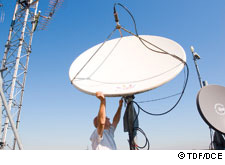|
2008, Digital Broadcasting for All:
Assessment and Outlook
 In 2008, the Conseil’s regulation dealt with social, cultural, economic and, technological issues: its goal was to continue working towards digital switch-over while guaranteeing that television and radio serve all our citizens, all of this in the prevailing context of far-reaching economic changes in both the private and public sectors, and of a shift in technology. In 2008, the Conseil’s regulation dealt with social, cultural, economic and, technological issues: its goal was to continue working towards digital switch-over while guaranteeing that television and radio serve all our citizens, all of this in the prevailing context of far-reaching economic changes in both the private and public sectors, and of a shift in technology.
2008 was a particularly rich year as regards the progress towards digital switch-over. The CSA observes that the French public’s enthusiasm for digital terrestrial television (DTT) has not faltered, as evidenced by the fast increase in the number of households receiving digital television three years ahead of the digital switch-over: over 35% of mainland France households have a DTT set top box; almost two households out of three receive DTT on at least one of their TV sets, whatever the receiving mode. In fact, DTT was the fastest growing digital reception mode during the period. It goes to show that French people fully embrace DTT as it provides an extended offer, both nationally and locally, of free-to-air channels in higher quality.
DTT coverage continues to make progress: at the end of 2008, 87% of the French population could receive DTT. Progress was registered in particular in those départements which were the least covered so as to serve the Conseil’s objective of a digital revolution that would not leave any part of the territory by the wayside.
With the same intent of avoiding any geographical or social digital divide, the Conseil made preparations in 2008 for the switch-over to digital broadcasting. The core principle is to place viewers at the heart of the process by ensuring continuity, simplicity and the lowest possible cost. These principles were taken onboard in the national analog switch-off scheme published by the prime minister in late December 2008. The first two regions to fully switch to digital will be Alsace and Basse-Normandie in the first half of 2010. Prior to that, experiments will be carried out in Coulommiers (switch-off on 4 February 2009), in Kaysersberg and Cherbourg. Analog switch-off will permit further expansion of local television. A large number of projects in highly populated areas were selected in 2008. When all of these channels start broadcasting, 41,000,000 of our fellow citizens will have access to a local channel. However, the Conseil is aware of the economic difficulties facing many local channels. It has suggested a set of measures to guarantee their duration and to facilitate their operation. It is also committed to continue issuing calls for tenders as they demonstrate faith in the future of local television and are an economic requirement in terms of advertising market and broadcasting cost.
 In 2008, the Conseil also drafted the “birth certificate” of the major innovations provided for in the law of 5 March 2007: high definition (HD), mobile television and digital radio. On 30 October 2008, four high definition channels were launched: TF1 HD, France 2 HD, Arte HD and M6 HD. Canal+ HD has been available to its subscribers since August 2008. This places France in the leading group of countries having launched off-air terrestrial (hertzienne terrestre) high definition thus providing viewers with access to a major technological development. The technology was expected with keen interest by channel editors who see it as the future format of television they all seek and as introducing for viewers a change in quality so radical, it is comparable, in certain respects, to the switch from black and white to color television. Viewers who are buying HD-ready equipment in ever growing numbers were just as keen. In 2010, over half of French households will be equipped to receive television in high definition. In 2008, the Conseil also drafted the “birth certificate” of the major innovations provided for in the law of 5 March 2007: high definition (HD), mobile television and digital radio. On 30 October 2008, four high definition channels were launched: TF1 HD, France 2 HD, Arte HD and M6 HD. Canal+ HD has been available to its subscribers since August 2008. This places France in the leading group of countries having launched off-air terrestrial (hertzienne terrestre) high definition thus providing viewers with access to a major technological development. The technology was expected with keen interest by channel editors who see it as the future format of television they all seek and as introducing for viewers a change in quality so radical, it is comparable, in certain respects, to the switch from black and white to color television. Viewers who are buying HD-ready equipment in ever growing numbers were just as keen. In 2010, over half of French households will be equipped to receive television in high definition.
Mobile television also corresponds to new television consumption modes on the viewers’ part. On 27 May 2008, BFM TV, Canal+, Direct 8, EuropaCorp, Eurosport, I-Télé, M6, NRJ 12, NT1, Orange Sport, TF1, Virgin 17 and W9 were selected by the Conseil out of 35 submitted files. At the same time, the minister for culture and communication selected France 2, France 3 and Arte to be assigned the three channels set aside for the public service. The Conseil wished to foster mobile television’s chances for success by selecting very well-know channels, attractive to the viewers and in innovative formats adapted to mobility. Eleven out of the thirteen selected projects already broadcast on digital terrestrial television. They make up more than 47% of the overall television audience and 74% of the private channels’ audience. Together with the public channels selected, 80% of the national television audience will be on mobile television.
The timing is now in the hands of operators. The Conseil has already sent draft legal agreements to the editors but the process is stalled. Channel editors and telecommunications operators have yet come to an agreement regarding the economic model for mobile television. The Conseil has always been very vigilant in this regard and is committed to supporting the various stakeholders so that the process may come to fruition.
Finally, in 2008, the Conseil gave the kick-off to the development of digital radio. There were several requirements facing the Conseil for digital radio to be attractive upon launch and to ensure professionals, equipment makers and listeners were onboard: digital radio had to, be easily understandable, benefit from a large coverage and have a potential for extension; another requirement was to convey a strong message to listeners and professionals by means of at least a duplicated radio offer and, in most cases, a richer one and the possibility for large networks of benefiting from a truly multi-city coverage, while protecting our radio landscape’s diversity, in particular, in the non-profit sector; finally, from the start, each and everyone had to be able to benefit from the new potentialities offered by digital radio, in particular in terms of associated data. The call for tenders issued by the Conseil on 26 March 2008 met these requirements. At the operators’ request, the closing date was postponed to 1 October and the technical conditions were improved. The call met with keen interest as evidenced by the 379 files received. The Conseil will announce the selection in the spring of 2009.
All of these innovations meet both the public’s and the professionals’ expectations. It is, therefore, quite natural that they be available to the largest number in over-the-air broadcasting, the only broadcasting mode making it possible for each and everyone to have access free of charge. The government stressed this requirement again in October 2008 when it introduced the Digital France 2012 (France numérique 2012) plan. As provided for in the law, most of the frequencies freed up by the switch-off of analog broadcasting will be used for the deployment of future broadcasting services. The Digital France 2012 plan forecasts that, in the end, the switch-off of analog networks will make room for eleven digital terrestrial television multiplexes covering at least 95% of the population and for two mobile television multiplexes covering 70% of the population. Any existing channel wishing to do so shall be entitled to broadcast in HD. Special attention has been paid to the conditions for the roll-out of digital radio. All conditions, therefore, are met for a new digital broadcasting industry to emerge: richer, more diverse, more innovative, in synch with the public’s expectations and providing a potential for economic growth. Such an industry must serve the needs of society. This belief is at the core of Conseil’s regulatory action.
 In 2008, the Conseil’s social regulation mission was translated in equal measures through its monitoring of broadcasts and through the positive missions with which it is entrusted and which make it a true ambassador of audiences. This year, the Conseil played a fundamental role in this respect by promoting social cohesion and combating discriminations. As part of the broadcasting media diversity observatory (Observatoire de la diversité dans les médias audiovisuels) it has established, the Conseil has commissioned a study on the representation of diversity on television. The study was carried out by Eric Macé, a sociologist. It consisted in a snapshot of DTT channels’ programs over one week and in a survey of persons present on the air according to how they are perceived by audiences in terms of gender, socio-professional categories and ethnic-racial markers. The findings of the study were presented by the Conseil on 12 November 2008. They are particularly alarming when compared to the objective of diversity representation on television set forth in the law. In the past ten years since the first study carried out by the Conseil in 1999, diversity has made very little progress on television. Those programs least reflecting diversity are precisely those playing a very important role in the construction of the collective national psyche (French fiction), those supposedly showing and studying the reality of French society (news show reports dealing with French subjects) and those in which there is a host and the audience participates such as entertainment shows and, especially, game shows. In 2008, the Conseil’s social regulation mission was translated in equal measures through its monitoring of broadcasts and through the positive missions with which it is entrusted and which make it a true ambassador of audiences. This year, the Conseil played a fundamental role in this respect by promoting social cohesion and combating discriminations. As part of the broadcasting media diversity observatory (Observatoire de la diversité dans les médias audiovisuels) it has established, the Conseil has commissioned a study on the representation of diversity on television. The study was carried out by Eric Macé, a sociologist. It consisted in a snapshot of DTT channels’ programs over one week and in a survey of persons present on the air according to how they are perceived by audiences in terms of gender, socio-professional categories and ethnic-racial markers. The findings of the study were presented by the Conseil on 12 November 2008. They are particularly alarming when compared to the objective of diversity representation on television set forth in the law. In the past ten years since the first study carried out by the Conseil in 1999, diversity has made very little progress on television. Those programs least reflecting diversity are precisely those playing a very important role in the construction of the collective national psyche (French fiction), those supposedly showing and studying the reality of French society (news show reports dealing with French subjects) and those in which there is a host and the audience participates such as entertainment shows and, especially, game shows.
Based on the findings of this study, the Conseil has engaged broadcasters in a constructive dialogue. A diversity “barometer” measuring any development will be published twice a year. The Conseil also intends to do some groundwork with all professions involved in broadcasting starting with journalism schools. The Conseil is hoping for rapid progress so that all French citizens can relate to French television.
Television for all also means program accessibility to the deaf and hearing-impaired and to the blind and visually-impaired. 2008 was an especially rich year in this respect: subtitling made progress towards reaching the 2010 objective of generalization and the public authorities took heed of the need to impose audio description requirements. The Conseil’s accessibility concerns found its operational translation in the creation in January 2009 of a working group specially dedicated to the issue.
In 2008, the Conseil also issued several major guidelines regarding child protection. In particular, it stressed the need for an all-encompassing notion of child protection on all screens. It co-sponsored with the ministry for families the broadcasting of a message underlining dangers on all screens and, in particular, on the Internet (“Where is Arthur?”). The message was broadcast free of charge by all over-the-air channels. In addition, this year, the Conseil renewed its advertising spot on the youth-suitability rating signs underlining the need for greater ownership by parents. Finally, on 22 July 2008, the Conseil also adopted a very important deliberation regarding television aimed at babies. In the text, the Conseil stresses that television may not be intended for children under the age of three as it is harmful to them as evidenced by the opinion issued by the ministry of health.
Public health is an issue to which the Conseil devoted a considerable amount of work in 2008. On 17 June 2008, the Conseil adopted a deliberation relating to the display of illicit drugs on television and radio designed in partnership with the Mission interministérielle de lutte contre la drogue et la toxicomanie (interministerial task-force to combat drugs and drug addiction). In addition, the Conseil also worked on a draft charter on combating obesity and in favor of healthy eating, later signed in 2009. Given the importance of the issue of health and, following the Grenelle de l’environnement (National Environment Roundtable), of sustainable development in terms of TV channels’ social role, the Conseil established a task-force devoted to these topics in January 2009.
2008 was a year of upheaval for both public and private French broadcasting. On 8 January 2008, the president of the Republic announced the start of a discussion on the complete cancellation of advertising on public channels. The announcement triggered discussions and debates among French professionals regarding the French public broadcasting sector’s editorial stance and financing. The Conseil took an active part in the debate by publishing in June 2008 a summary document entitled “Observations by the Conseil supérieur de l’audiovisuel in relation to the editorial lines of groupe France Télévisons’ channels” (Observations du Conseil supérieur de l’audiovisuel sur les lignes éditoriales des chaînes du groupe France Télévisions). Some of its recommendations were included in the law relating to the modernization of the public broadcasting service (loi relative à la modernisation du service public de l’audiovisuel).
 The terms and conditions of the reform are specified in further details in the law of 5 March 2009. One of the main points is the transformation of Groupe France Télévisions into a single national program company – while avoiding the single window effect – with a single set of specifications (cahiers des charges) to set forth the characteristics and identity of France Télévisions’ channels’ editorial lines, as recommended by the Conseil in its June 2008 report. The end of advertising on France Télévisions between 8 p.m. and 6 a.m. is already in force; upon completion of analog switch-off, there will not be anymore advertising on France Télévisions. The conditions in which advertising will be cancelled on Réseau France outre-mer (RFO) (public overseas network) have also been set forth. Finally, the text provides for the overhaul of the French public broadcasting sector’s financing. The governance of public broadcasting companies has been modified, in particular, through the execution of a contrat d’objectifs et de moyens (agreement relating to objectives and means) whose term will match that of the chair and which will be forwarded to the CSA prior to execution. As regards the appointment or dismissal of public broadcasting companies’ chairs, the requirement that the Conseil give an assenting opinion is tantamount to a power of joint decision. The terms and conditions of the reform are specified in further details in the law of 5 March 2009. One of the main points is the transformation of Groupe France Télévisions into a single national program company – while avoiding the single window effect – with a single set of specifications (cahiers des charges) to set forth the characteristics and identity of France Télévisions’ channels’ editorial lines, as recommended by the Conseil in its June 2008 report. The end of advertising on France Télévisions between 8 p.m. and 6 a.m. is already in force; upon completion of analog switch-off, there will not be anymore advertising on France Télévisions. The conditions in which advertising will be cancelled on Réseau France outre-mer (RFO) (public overseas network) have also been set forth. Finally, the text provides for the overhaul of the French public broadcasting sector’s financing. The governance of public broadcasting companies has been modified, in particular, through the execution of a contrat d’objectifs et de moyens (agreement relating to objectives and means) whose term will match that of the chair and which will be forwarded to the CSA prior to execution. As regards the appointment or dismissal of public broadcasting companies’ chairs, the requirement that the Conseil give an assenting opinion is tantamount to a power of joint decision.
At the same time, the French private broadcasting sector underwent tremendous changes, in particular, from a financial perspective. In addition to the increasing scattering of audiences eventually leading to a scattering of advertising revenue, the advertising environment deeply changed in 2008. The reform of advertising on France Télévisions, which may lead to transfers to other editors, took place at the same time as the introduction in France of changes in the rules relating to advertising broadcasting. Under the décret of 19 December 2008, the average daily duration of advertising on incumbent private channels was extended to 9 minutes from 6 minutes (a relaxation of standards is also provided for in respect of digital terrestrial, cable and satellite channels). In addition, the maximum duration of advertising (12 minutes) in a given hour is now calculated on clock hours instead of sliding hours. Under the law of 5 March 2009, private editors also have the right to introduce a second advertising cut during the broadcasting of audiovisual and cinema works.
 These legislative reforms were introduced at a time when the multimedia advertising market was undergoing structural changes. In particular, since 1 January 2007, large retail chains are allowed to advertise on television; the audience of digital terrestrial television (DTT) has rapidly grown (and grew even more rapidly in 2008) taking market shares away from incumbent national channels; the advertising revenue of the traditional mainstream media (the radio and the print media especially), unable to renew their attractiveness for advertisers, has decreased; finally, the Internet has grown dramatically. The confirmation of the economic slowdown in 2008 should soon have an impact on advertising investment for which experts expect a decrease, according to their latest forecasts. These structural, regulatory and economic changes all contribute to creating a climate of uncertainties regarding the possible response of advertisers and the media advertising revenue in 2009 and beyond. These legislative reforms were introduced at a time when the multimedia advertising market was undergoing structural changes. In particular, since 1 January 2007, large retail chains are allowed to advertise on television; the audience of digital terrestrial television (DTT) has rapidly grown (and grew even more rapidly in 2008) taking market shares away from incumbent national channels; the advertising revenue of the traditional mainstream media (the radio and the print media especially), unable to renew their attractiveness for advertisers, has decreased; finally, the Internet has grown dramatically. The confirmation of the economic slowdown in 2008 should soon have an impact on advertising investment for which experts expect a decrease, according to their latest forecasts. These structural, regulatory and economic changes all contribute to creating a climate of uncertainties regarding the possible response of advertisers and the media advertising revenue in 2009 and beyond.
These economic uncertainties have major consequences in the broader context of the overall under-financing of the French broadcasting industry. The economic well-being of TV channels is essential to the development of the whole broadcasting industry and, in particular, to the financing of creation. For these reasons, public authorities should pay special attention to the economic position of private channels: it affects the entire chain of creation. Broadcasting operators are also now faced with telecommunications operators turning to broadcasting. Telecommunication groups have shown interest for, broadcasting production, the edition of pay channels (Orange Sports and Orange Cinéma Séries) and of a mobile television channel; at the same time, the broadcasting of non-linear services has developed. In such a context, competition between distributors rages for channels and, generally, for content. The Conseil has received many dispute settlement petitions and many requests for opinions to the Conseil de la concurrence (competition council).
New operators such as Dailymotion and Youtube have also emerged. These newcomers pose a challenge to creation: in the classic linear model, creation is financed through channels’ legal obligations, distribution time constraints (chronologie des medias) and exclusivity. Its financing must now be re-thought through. A roundtable of all stakeholders should be organized as soon as possible to find efficient modes of remunerating content.
2008 was also the year during which greater account was taken of the need to regulate online audiovisual content. For audiences, television is now everywhere, and no distinction is made between the various kinds of screens and broadcasting modes, or between linear or non-linear services.
The Conseil’s remit has developed in line with these changes: since 2004, it includes webTV and webradios and, since the adoption of the law of 5 March 2009, it includes on-demand audiovisual media services. The Conseil is now in charge of regulating these services, mainly, namely, catch-up TV and video-on-demand. A single legal framework applicable to linear and to on-demand services is provided for in the law resulting in matching obligations while different levels of regulation are underlined. The Conseil approves of specific rules applicable to on-demand audiovisual services as it will provide for greater flexibility in their obligations. Nevertheless, the law provides that the enhancement of French and European audiovisual and cinema works be effective. The Conseil is working on the speedy implementation of the regulation relating to on-demand audiovisual media services.
Even though video sharing websites are not included in the Conseil’s remit, this is an important first step towards the end of the artificial distinction between linear and non-linear services as such a distinction no longer matches the economic reality nor the audiences’ habits.
Many of the Conseil’s missions cannot stop at the Internet’s gate any longer. There can no longer be a strict delineation where viewers do not see it. The content approach is the only one capable of meeting the public’s expectations.
The kind of regulation wielded by the Conseil supérieur de l’audiovisuel is fundamentally modern. As underlined by Michel Boyon, the Conseil’s chair, this type of regulation is mindful of the interests of the broadcasting industry, a fully-fledged economic sector; this type of regulation is at the leading edge of technological innovation, a major point this year with the switch-over to digital broadcasting which will affect all French people; this type of regulation also takes heed of the public’s societal concerns such as diversity. What is being built today, 20 years after it was created, is the Conseil supérieur of digital broadcasting, more than ever in synch with the professionals and the public. a fully-fledged economic sector; this type of regulation is at the leading edge of technological innovation, a major point this year with the switch-over to digital broadcasting which will affect all French people; this type of regulation also takes heed of the public’s societal concerns such as diversity. What is being built today, 20 years after it was created, is the Conseil supérieur of digital broadcasting, more than ever in synch with the professionals and the public.

|